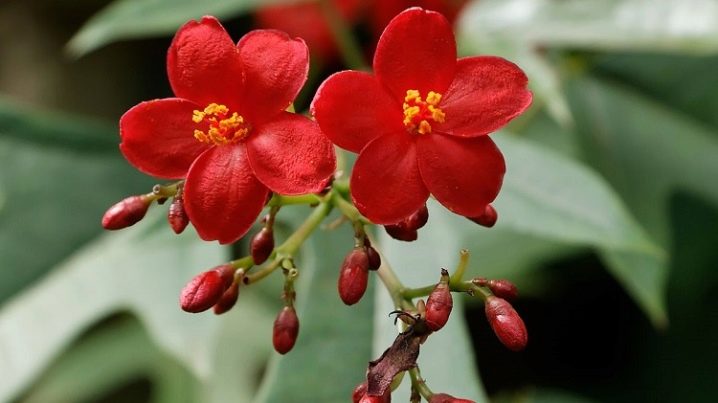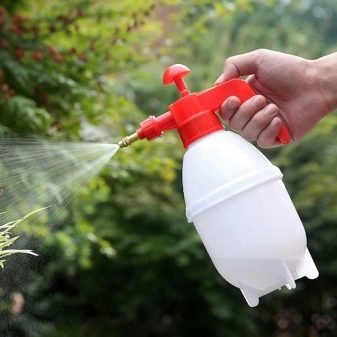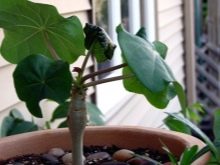What does a jatropha look like and how to grow it?

Tropical jatropha is increasingly being chosen by growers for growing at home. However, due to the presence of toxic components in the composition, it is not recommended to keep it in places where small children and pets live.


general description
The plant with the unusual name jatropha is a representative of the Euphorbia family. There are more than 190 varieties of this culture, which take the form of a tree, shrub and even a succulent. However, they all contain toxic substances that can cause skin irritation or even poisoning. Evergreen perennials are deciduous. Some of them are able to spend the whole winter with a bare trunk, and with the arrival of spring, release flower arrows and form young foliage. Jatropha flowers, which are small in size, are combined into umbellate inflorescences of different shades of red.
With proper care, the plant blooms throughout the growing season, from spring to almost the end of summer. The culture stores moisture in the thickened zones of the trunk, and therefore copes with prolonged drought without any problems. By the way, the lignified stem most often thickens downwards, outwardly resembling a bottle. The root system of the plant is powerful and well developed. Wide leaf blades, colored dark green, reach 30 centimeters in length. The plus is that she is practically not bothered by insects, not particularly eager to consume toxic substances.
At home, jatropha can live up to 15 years and stretch from 80 centimeters to 1.5 meters. Every year it will grow by 20-35 centimeters.



Popular species and varieties
Despite the huge number of varieties of jatropha, only a few of them are suitable for indoor and greenhouse cultivation.
- Jatropha gout, she is jatropha gout, is remembered for the unusual shape of its trunk, which outwardly resembles a Greek amphora. The plant reaches a height of 1 meter, thanks to a massive peduncle. In the spring, umbellate inflorescences first appear on a deciduous bush. Coral buds do not open, however, until after the leaf blades have formed. The flowering culture continues from spring to autumn. For seed formation, gout requires artificial pollination. It should also be mentioned that the five-lobed leaf blades change their color over time: from glossy pale green to matte dark. A bluish bloom is present on the petioles and in the lower part of the leaves.

- Rare jatropha kurkas in indoor conditions it forms a small shrub, while in the wild it grows up to 5-6 meters. The large fruits appearing on the plant gave it a second name - "Barbados nut". Heart-shaped leaves with a small dissection are painted in a rich green color. The yellowish flowers combine into unusual looking inflorescences. The poisonous variety is actively used in agriculture, paper industry, medicine and perfumery.

- Jatropha whole-edged also not a common culture. Under natural conditions, it forms a small tree, the height of which does not exceed 4 meters, but, as a rule, only shrub forms are grown in apartments. The plant responds well to pinching, which allows you to shape the contour in all sorts of ways.Rounded leaf blades are characterized by the presence of an even edge. The racemose inflorescences are colored coral, which explains the second name of the plant - "coral flower". With proper care, the culture continues to bloom throughout the year.

- Jatropha dissected, also known as "multifeed", looks like a small palm tree. In its natural habitat, it is a shrub that reaches 3 meters in height. Large leaf blades of the plant are divided into 7-10 lobes. In most cases, they are painted in a dark green shade with a lilac tint.

- For jatropha mahafalensis the presence of thick stems covered with brown bark is characteristic. Dissected green leaves sit on long petioles. During flowering, the bush is covered with white or creamy inflorescences. In nature, the height of mahafalensis reaches 5-6 meters.

Growing
Growing jatropha at home requires a number of conditions.
Landing
Before planting seeds, the soil in the container must be moistened. The previously soaked material is laid out on the surface, but it is not covered with earth. The container is tightened with cling film or covered with glass, after which it is removed into a well-lit space with a temperature of +25 degrees.
Crops will need to be regularly sprayed with warm water, as well as aired once a day. When sprouts appear after a couple of weeks, the shelter should be removed, and the appearance of 2 leaves indicates the need for a pick. When young plants already have 5-6 leaves, it will be possible to plant the jatropha in their permanent habitat.


Conditions
The plant requires good lighting during growth and flowering. You can even leave it in the sun for the whole day and only shade it lightly in the afternoon so as not to burn the leaves. If the jatroph lacks light, then its internodes will stretch ugly, and the appearance will deteriorate significantly. Culture feels best on the sills of windows facing east. In principle, she likes both the southeast and the southwest, but being in the north will become disastrous: the plant will wither, slow down in development and generally refuse to bloom. In fact, it is possible to "accustom" the jatropha to penumbra, but this has to be done from an early age.
A place where decorative culture dwells, must be ventilated daily, however, it will have to be protected from drafts, if necessary, taking it to another room. In summer, the flower can be rearranged on the balcony or glazed loggia.
From March to October, the plant will have to live at temperatures from +18 to +22 degrees, and during wintering, this interval decreases to + 14-16 degrees. The culture is indifferent to the level of moisture, but responds well to the regular cleaning of leaf blades from dust.


Watering and feeding
During the growing season, the jatrophy requires moderate, but constant watering with a warm, settled liquid. It is better to focus on the condition of the top layer of the soil, which should have time to dry out. As a rule, the frequency of the procedure in the summer is once every 10 days. In autumn, before dropping the foliage, the jatropha is irrigated 3 days after the soil dries out. Waterlogging of the soil will lead to decay of the root system, and therefore it is important to attend to the drainage layer. From the moment the leaves fall off, full-fledged irrigation stops until the spring appearance of new buds.
Complex liquid fertilizers for cacti, used in half the dosage, are suitable as top dressing for the culture. In spring and summer, they have to be applied once a month, in autumn the frequency of use is reduced, and in winter, top dressing is generally canceled.


Transfer
A jatropha transplant should be carried out in early spring, preferring the transshipment method and protecting yourself with gloves and goggles. In general, this procedure is allowed to be carried out every three years, but only as needed.The plant needs a pot that is wide, but not too deep to accommodate both a small root system and a thickened stem.
The soil is suitable for the culture, light, well permeable to moisture and air, with a neutral acidity of 6.5-7.5 pH. A ready-made soil mixture for succulents or a homemade substrate made of turf, peat, leafy earth, perlite and vermiculite is suitable for the plant. To enhance drainage properties, crushed brick can be added to the composition.



Reproduction
Jatropha propagates either by seed or cuttings. The first method has already been mentioned above, but it should be mentioned that freshly harvested material that appears after artificial pollination is best manifested. Propagation by cuttings requires cutting of small fragments of apical shoots, the length of which does not exceed 10-15 centimeters.
They are dried in the open air until the poisonous juice stops secreting. Next, the bases of the cuttings are dipped in a stimulating drug, planted in the ground and covered with a plastic bag or half of a plastic bottle. After 5 weeks at a temperature of +27 degrees, the plant can be planted in an individual pot.


Diseases and pests
Although the jatropha rarely suffers from viruses or insect exposure, it sometimes develops root rot due to over-watering. In this case, you can try to revive the plant if, after washing with hot water, cut off all the spoiled shoots, treat the wounds with charcoal and transplant the flower into new soil.
Culture attracts from insects:
- spider mite, as evidenced by yellowing and falling leaves;
- thrips, deforming flowers;
- whitefly, due to which the plates are covered with specks.
Since pests attack only a weakened plant, it will be possible to save it by providing it with proper care and suitable conditions. In addition, the insects will have to be washed off the leaf blades with warm water, and the jatropha itself will then be treated with insecticides.



Possible care errors
It is very easy to fill the plant, and it is this mistake that is most often found among novice gardeners. In this case, it is recommended to reduce the amount of water and, if it is used cold, replace it with warm one. Irrigation adjustments are also required in the event of wilting of the leaf blades. Slower growth of a jatropha may be a symptom of being overfed. The gardener needs to reduce the dosage next time and apply fertilizer only to wet soil.
If the leaves of the plant become smaller, then the problem is either a lack of light or a lack of nutrients. From hypothermia, the leaves fall off, and from overheating, they become less attractive.
Falling foliage in autumn, however, is a completely normal process that prepares the crop for a dormant period. In the absence of other symptoms, you can either do nothing, or lower the temperature by 2-3 degrees.










































































































The comment was sent successfully.